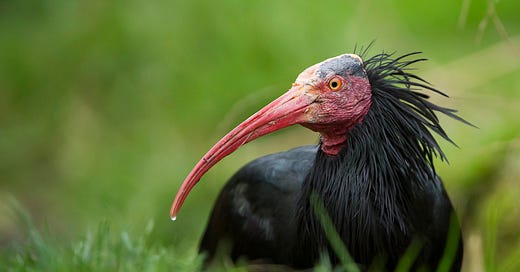This post today is basically a Part 2 to Locating ourselves in the wide range of possibilities for restorative action from August 31. I’ve been following the migration of the thirty-six Northern Bald Ibises and their human foster mothers on Instagram.
Barbara Steininger, wildlife ecologist, is on the migration and is posting awesome videos regularly at @babs_stein. Make sure to check out her clips.
As of the most recent post, birds and their humans made it to Spain. They’re on their way to Andalusia. And why? According to the waldrappteam website:
Global warming is also becoming a challenge for the Northern Bald Ibis. The birds of the colonies in the northern foothills of the Alps are having increasing problems flying over the Alpine barrier in autumn. A new migration corridor to Andalusia should enable them to reach a suitable wintering area without being hindered by the barrier of the Alps.
Dacher Keltner, co-director of The Greater Good Science Center and author of Awe: The New Science of Everyday Wonder and How It Can Transform Your Life, writes about his research on awe:
“What most commonly led people around the world to feel awe? Nature? Spiritual practice? Listening to music? In fact, it was other people’s courage, kindness, strength, or overcoming.”
The Waldrapp team ticks all the boxes for me: courageous, flying hundreds of miles in this microlight aircraft; kindness to care so profoundly about the fate of these birds; strength to persevere; and overcoming hardships and disappointments along the way to see this awesome migration through. And the larger team has been doing it again every year since they started.
That’s a story worth telling and retelling.
Moving along with the Part 2 theme this week, the largest dam removal in US history—the JC Boyle, Copco 1, Copco 2, and Iron Gate dams on the Klamath River—is complete, reopening more than 400 miles of the river—after decades of effort. Reporting by BBC journalist Lucy Sherriff gives a little more backstory on this historic restoration project and tells the story of the next phase—gathering, propagating, and planting 18 billion native seeds.
"It's so important that this is indigenous-led because usually you see three, five, 10-year timelines when it comes to restoration. When it comes to indigenous mindsets, it's a seven-generation plan. How is this plant going to affect us 100 years from now? Taking care of a plant that your great-grandmother took care of puts a lot of perspective into life. And this is the first step in reclaiming our ability to take care of the Klamath River."
—Brook Thomson, member of the Karuk and Yurok tribes, northern California
If you didn’t read ‘The river is free’: historic US dam removal nears completion, from last week’s post, read it now.
Here’s an excerpt:
The Klamath was once known as the third-largest salmon-producing river on the west coast. But after power company PacifiCorp built the dams to generate electricity between 1918 and 1962, the structures halted the natural flow of the river and disrupted the lifecycle of the region’s salmon, which spend most of their life in the Pacific ocean but return up their natal rivers to spawn.
The fish population dwindled dramatically. In 2002, a bacterial outbreak caused by low water and warm temperatures killed more than 34,000 fish, mostly chinook salmon. That jumpstarted decades of advocacy from tribes and environmental groups, culminating in 2022, when federal regulators approved a plan to remove the dams.
And follow that with ‘Anything that can be built can be taken down’: The largest dam removal in US history is complete - what happens next? It is an extraordinary story of interconnection, vision, and perseverance.
We were told it was never going to happen. That it was foolish to even ask for one removal. We were asking for four.
– Brook Thompson
Be well. Thank you for your curiosity and making time to read The Interconnect. Welcome to the new readers this week. I’m glad you’ve found your way here and I hope you stay a while. Please consider sharing this post with family, friends, teachers, and/or colleagues who might appreciate it. And share the stories with the young people in your life. These are stories they need to hear.




